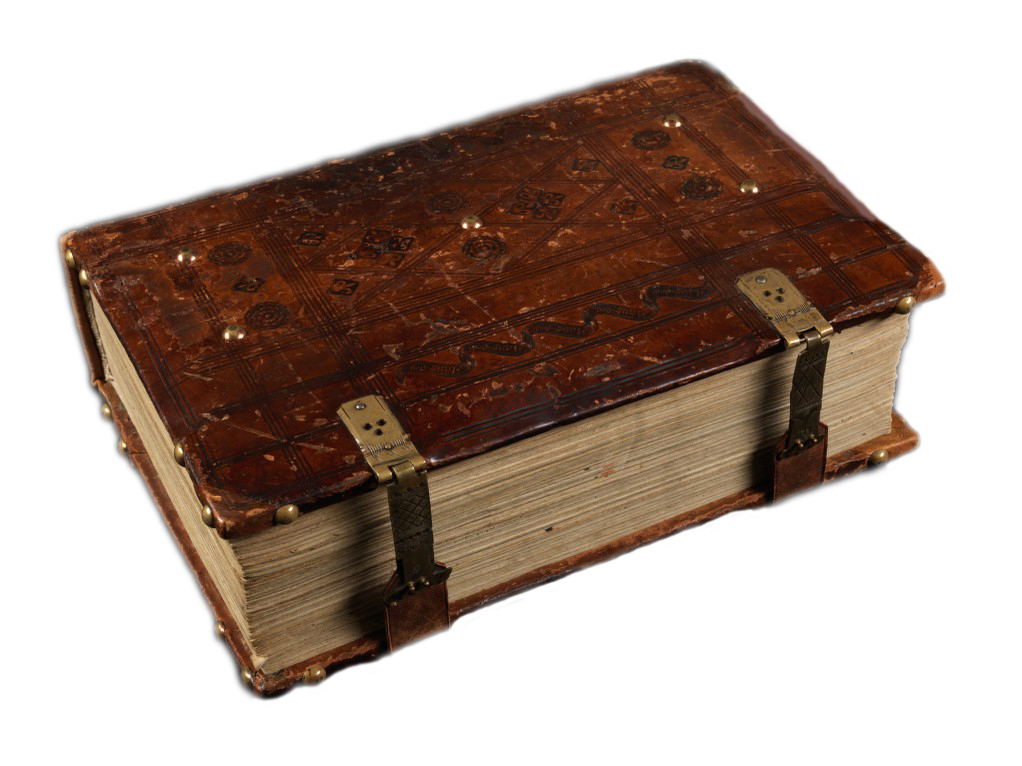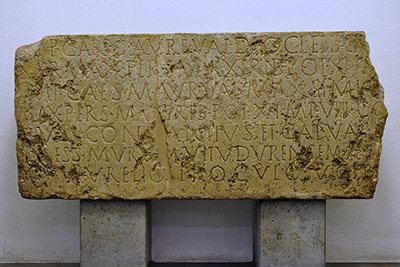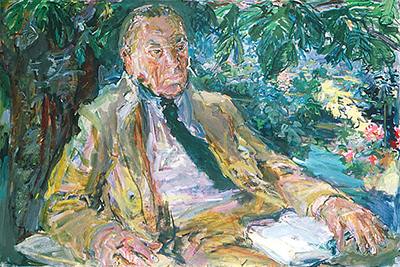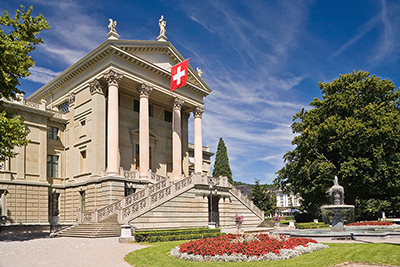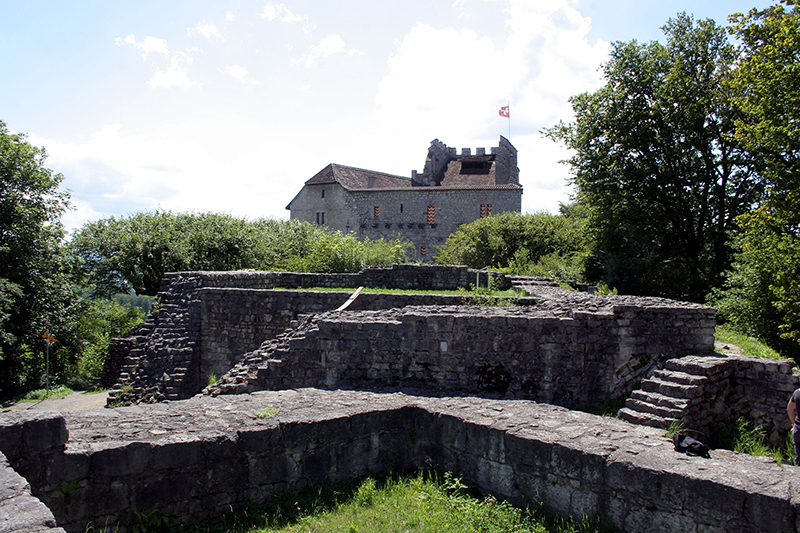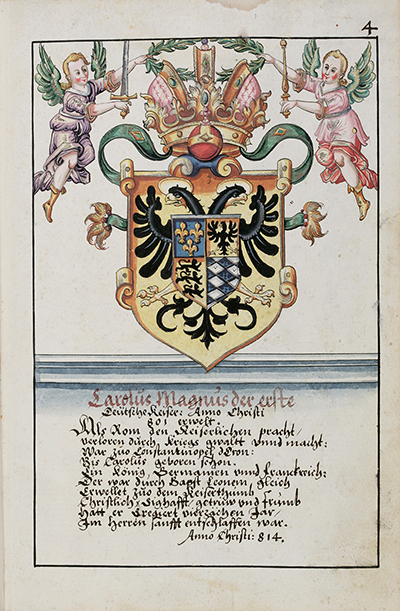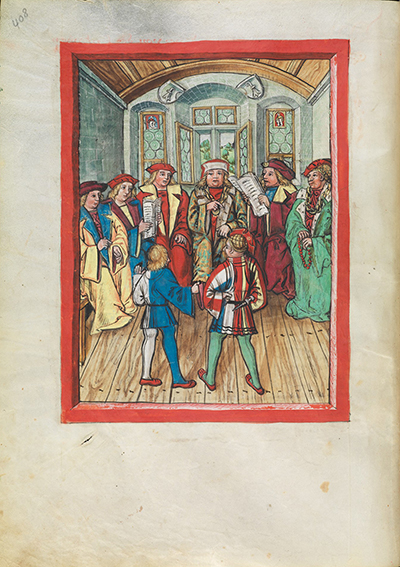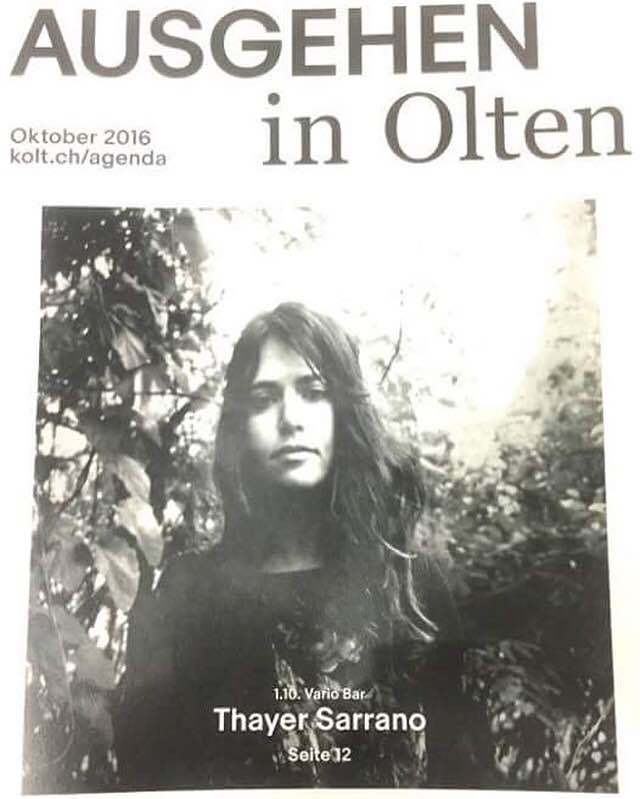— The Scriptorium —
Guildwater News Archive
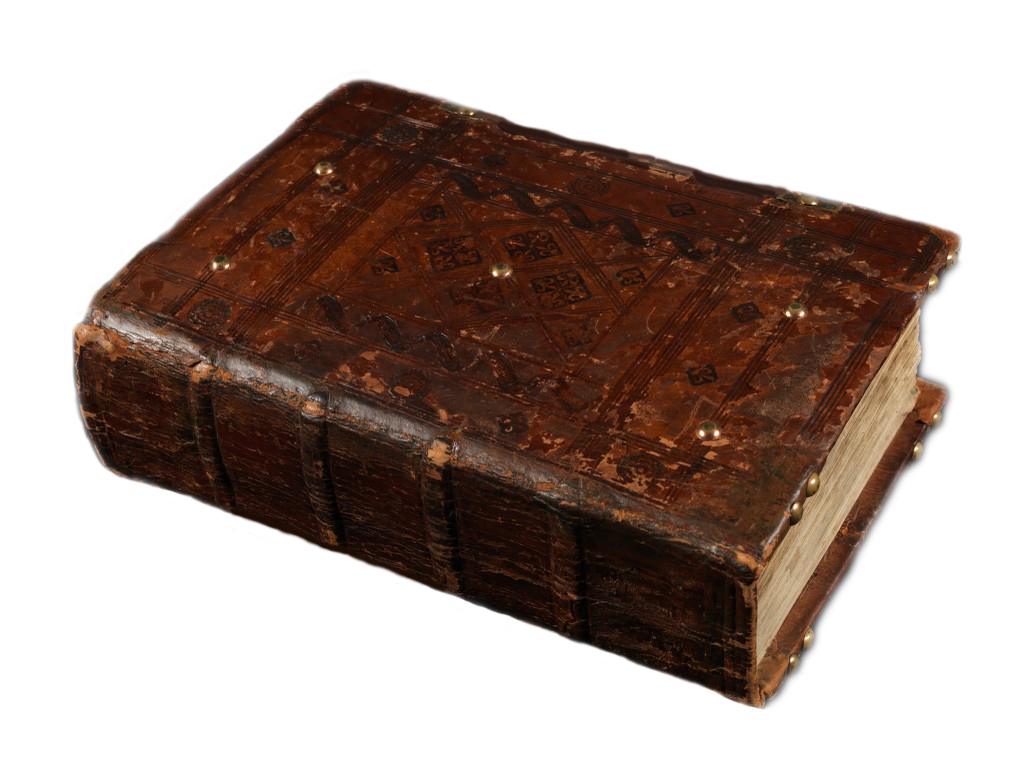
THAYER SARRANO
(Winterthur, Switzerland)
October 03, 2016 (Monday) - Thayer Sarrano visits Winterthur, the fourth of six Swiss dates. Thayer is accompanied by Ted Kuhn (bass) and Jason Nazary (drums). Together they play the Portier. The city of Winterthur is located in the canton of Zürich, and is situated 14 miles from the canton capital city of Zürich itself. Roman settlements in these areas date back to at least the very late BC period. But fuller testament is found in later centuries, in Oberwinterthur, on the outskirts of Winterthur itself, known to the Romans as Vitudurum. There you can see remnants of a Roman fort-castle settlement, and even hear holdovers in the toponymics (or place-names) of -- repeat aloud with us -- "Winterthur" and "Vitudurum." Epigraphy on the surviving keystone (image below) of the Roman fortress declares itself built upon the instruction of Diocletian in the late 200s. Diocletian was a pivotal Roman Emperor who, faced with the bureaucratic challenges of ruling the Mediterranean Basin, divided the empire into four large administrative units ruled by a Tetrarchy. Vitudurum was situated in the Roman province of "Germania Superior," inside the Roman limes, the fortified military borders that stretched and separated Rome from the Germanic tribes beyond the Alps, Rhine, and Danube. The Germanic tribes -- Ostrogoths, Visigoths, Vandals, being the most recognizable among countless others -- would be responsible for the collapse of the western half the Roman Empire in the fifth century. When, in the wake of successive waves of invasions, Odoacer deposed Romulus Augustus in 476 at Ravenna, it represented the effective end of the western empire, although the eastern portion, centered in Constantinople, endured until 1453. The collapse of Rome created a power vacuum in the West, one that would eventually be filled by the Carolingian Holy Roman Empire of Charlemagne over 300 years later.
(Photo: Roland zh)
We Guildwater Scribes thought we were done with those nasty Habsburgs, but it turns out that Winterthur became a Habsburg possession in the late 1200s. This was just the moment that the Habsburg family was "migrating" from the Aargau (of modern Switzerland) to Austria. Had the Habsburgs been allowed to keep their lands in the Aargau, they could have expanded their power base more broadly in these regions, and, conceivably, over time, patched together a contiguous territory that linked up to their newer Austrian possessions. It is easy to imagine, then, why the neighboring Swiss cantons were wary of the new imperial family and its future designs, and banded together in a Confederacy. Such potential developments are not as unreasonable as they may seem, considering that Winterthur's close neighbor, Zürich, occasionally sided with the Habsburgs against the other budding Swiss cantons. For example, in 1315, at the Battle of Morgarten, Zürich fought on the side of the Habsburgs. Later, Zürich did finally join the Swiss Confederacy, in 1351. But then, in the middle of the next century, Zürich was expelled, only to be later readmitted, as a consequence of disagreements with fellow member cantons over the regions of Toggenburg. Following all this, the Habsburgs, finally, after having lost their Aargau lands in 1415, decided to sell Winterthur to the city of Zürich itself, in 1468. But enough of these expulsed Habsburgs already. We Scribes wrote so much about them over the last few days, we dreamed last night that they laid siege to Castle Guildwater, breached the ramparts, and ran off with our parchment, before establishing a new empire in our office suites, commandeering our conference table for their gluttonous banquets.
Oskar Kokoschka (1886-1980)
Kunstmuseum (Winterthur)
(Source: Schweizerisches Institut für Kunstwissenschaft)
More interesting to us Guildwater Scribes is the Orchester Musikkollegium Winterthur, itself first established in 1629. There is no orchestra active longer in Switzerland. The recent re-flowering of the Orchester Musikkollegium stems from the first half of the twentieth century, when Werner Reinhart extended his generous patronage. The Reinharts were wealthy industrialists who ran a Winterthur-based trading company, but one with connections as far-reaching as India. Not involved with the family business on a day-to-day basis, Werner Reinhart was a full-time patron of the arts, aiding even authors. For example, he installed the Bohemian-Austrian writer Rainer Maria Rilke at the Rychenberg -- the grandiose Reinhart family estate in Winterthur, which now belongs to the Musikkollegium and its archives -- where Rilke wrote some of his later works. Werner Reinhart also sponsored painters -- Oskar Kokoschka and René Auberjonois, to name two. The image above is Kokoschka's portrait of his patron in 1947. Werner Reinhart, however, was not nearly as interested in the plastic arts as his brother, Oskar Reinhart, whose collection is now housed at the museum bearing his name in Winterthur. The Oskar Reinhart Museum is right around the corner from the Stadthaus (depicted below) -- a government administrative building, where the Musikkollegium regularly offers subscription concerts. Oskar Reinhart's collection includes some 500 paintings and sculptures, as well as some 7,000 prints. The works are primarily devoted to Swiss and German, but also includes Austrian, artists. Of particular note among the Germans are the works of Caspar David Friedrich and Max Liebermann. Among the Swiss there is Arnold Böcklin, Ferdinand Hodler, and Giovanni Giacometti. Giovanni was the father of the famed sculptor Alberto Giacometti, both born in the southeastern Swiss canton of Grisons.
(Photo: Ikiwaner)
If Oskar Reinhart practically cornered the Winterthur market on painting, while his brother Werner only dabbled there, Werner's philanthropic love of music raised the Musikkollegium to new heights. Werner Reinhart placed the Winterthur orchestra under the direction of the famed conductor Hermann Scherchen from 1922 to 1950. Scherchen was himself a native of Berlin. Our Guildwater Scriptorium possesses nineteen of the Haydn symphonies that Scherchen recorded in the 1950s, for Deutsche Grammophon, with the Westminster and the Vienna State Opera Orchestra. We particularly enjoy the adagio movements of both the Symphony No. 44 in E Minor - "Mourning," and Symphony No. 49 in F Minor - "La Passione." Languorous -- in the good sense -- is a word that slumbers aptly to mind. Scherchen, in addition to building out the Musikkollegium's manuscript library under Reinhart's instruction, promoted modern composers of his own day. We will note Arnold Schoenberg, Igor Stravinsky, and Arthur Honegger. Although Swiss, and studying initially at the conservatory of neighboring Zürich, Honegger came later to be most associated with the loose collective of composers known as Les Six, championed by the writer Jean Cocteau, in Paris of the 1920s. (The sounds of Honegger's Symphony No. 2 in D fills the halls of our Scriptorium, as we scratch this parchment.) Despite his activities in Paris, Honegger also composed and guest conducted for the Musikkollegium in Winterthur. Other noteworthy figures associated with the Orchester Musikkollegium include the great Wilhelm Furtwängler and Vladimir Ashkenazy. As recently as August of this year, Thomas Zehetmair was appointed conductor of the Orchester. As a result of Scherchen's endeavors, in the very place where Werner Reinhart entertained countless artists, and Rilke once wrote, the Rychenberg Foundation and the Musikkollegium archives in Winterthur house original autographed scores by Mozart, Haydn, Schubert, and Puccini, as well as over a hundred original letters of Brahms.

THAYER SARRANO
(Olten, Switzerland)
October 01, 2016 (Saturday) - Thayer Sarrano and her Tour Europa wheel up to the more northerly reaches of Switzerland. To the city of Olten, Thayer goes, situated as it is in the canton of Solothurn, to inspect and stomp the stage of the Variobar. When the dream grunge ambassadress / Botschafterin Sarrano arrives there, she will be accompanied by her loyal musical attachés, bearing portfolios of good will and rhythm -- Ted Kuhn (bass) and Jason Nazary (drums) -- all-around groovy cats. This is the third of Thayer's six shows in the Confoederatio Helvetica (CH), known in the English-speaking world as Switzerland. As mentioned in our previous chronicles of Thayer's Tour Europa, portions of modern day Switzerland, by the mid-1400s, although still formally part of the larger Holy Roman Empire of the Habsburgs, had begun to develop and push along a separate historical pathway. Originating in the very late 1200s, the Swiss Confederation had, by the mid-fifteenth century, evolved to include, listed alphabetically: Bern, Glarus, Lucerne, Schwyz, Unterwalden, Uri, Zug, and Zürich.
(Photo: Tage Olsin)
Swiss developments were complicated by the fact that the Habsburgs, beginning with Rudolf in the late 1200s, began their slow rise to dominate, eventually, the Holy Roman Empire. In the very same era that Rudolph first controlled the imperial crown, the Habsburg family also acquired the duchy of Austria, from the Babenburgs. All the same, it was only later in the 1400s that the Habsburgs finally establish their monopoly over the imperial throne, ruling without interruption from the House of Luxembourg, Nassau, or Wittelsbach. Since, over the next seven centuries, the Habsburgs were intimately associated with Austria, it is easy to forget that their original patrimonial estates were located in the Aargau, which the family acquired earlier in the eleventh century. The Aargau is a canton in the north of modern Switzerland. It is located just to the east of the Soluthurn canton in which the city of Olten is itself found. The stage of the Variobar is, in fact, a mere 19 miles from the remnants of Habsburg Castle, their patrimonial seat, which can still be visited today, and is pictured below. Members of the Swiss Confederation, not long after their victory at the Battle of Bregenz (1408), which we Guildwater Scribes chronicled yesterday, confiscated in 1415 Habsburg lands in the Aargau, dividing some of the territorial spoils among themselves. The image above comes from the Wappenbuch of Hans Ulrich Fisch. It is a family heraldry history of the Habsburgs, told in rhyming verse, no doubt to aid memorization, and to encourage even the instruction of children – Habsburg propaganda. The manuscript reveals many things. We shall underline two. First, this particular page makes it clear that the Habsburgs traced their Holy Roman Empire back to the Carolingian Empire, namely that of Charlemagne (Carolus Magnus), or Charles the Great. Second, this manuscript is presently found in the Staatsarchiv of the Aargau, a point to which we shall return.
The next significant date pertaining to these broad Swiss developments toward independence is 1499 -- the Battle of Dornach -- which was part of the broader Swabian War. The conflict came about for numerous reasons, not least of which were the fresh marital ties between Mary of Burgundy and the Holy Roman Emperor Maximilian I -- a Habsburg. This alliance fanned the competitive flames between the Habsburgs of Austria and the Valois of France. Both dynasties wished to snatch up the last vestiges of what had once been a Burgundian kingdom, dating back to the fifth century. From the perspective of the Swiss Confederation, potential Habsburg control of the duchy and county of Burgundy meant that the imperial family would be practically back in town, virtually across the street from the very patrimonial estates that the Swiss had in 1415 confiscated in the Aargau. This Swabian War was but one part of a broader Habsburg-Valois conflict that stretched off and on from the 1490s to 1559, and engulfed the Italian peninsula, and, in this case, the Swiss Confederation. In this particular episode, the troops of Maximilian fought the Swiss at Dornach, and lost, in 1499. Peace negotiations at nearby Basel that same year (depicted in the image below), granted real concessions to the Swiss cantons. For instance, the imperial ban against the very existence of the Confederation was lifted. Yet, technically, on paper, it still remained part of the broader Holy Roman Empire.
Eidgenössische Chronik des Luzerners (1513)
(Source: Luzern, Korporation Luzern)
Dornach is situated in the Canton of Solothum, about 35 miles north of its largest city -- Olten, where the Tour Europa of Thayer Sarrano visits today. Dornach is also located just south of Basel, where the peace for the Swabian War was negotiated, and which dream grunge ambassadress Sarrano and her envoys (Kuhn and Nazary) of good will and rhythm shall visit on October 5th. The Habsburgs may have been expelled from the Aargau even more thoroughly in 1499 than in 1415, but, legally speaking, the Aargau and the larger Swiss Confederation were still part of the broader Holy Roman Empire. To return to the second image up above, the Wappenbuch of Hans Ulrich Fisch, found in the Staatsarchiv of the Aargau, its publication date of 1627 is revealing. It was published in the virtual middle of the 30 Years' War (1618-1648), almost as if to remind the Aargau that their Habsburg rulers of yesteryear might soon return. The 30 Years' War engulfed most all of Europe, was as much a religious as a political conflict, devastated the lands and peoples of what is now modern Germany, and severely hampered Habsburg continental authority. They would not be returning to the Aargau. This war is far too complex an affair for us to outline here. Besides, our pots of ink are running low, our parchment thin with quill scratching, and we Guildwater Scribes are easily wearied by tales of battle and war. Suffice it to say that it was only at the conclusion of that conflagration that the Swiss Confederation would formally and legally receive its independence -- by the Peace of Westphalia (1648). The process that began in the late 1200s was now complete.

Ausgehen in Olten
(Photo Art: Jason Thrasher)
(Image Courtesy of: Interstellar Music)
— Guildwater Archive —
